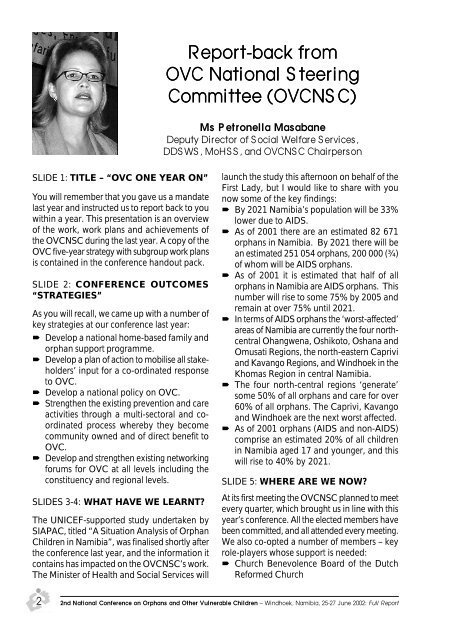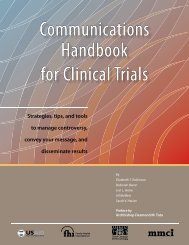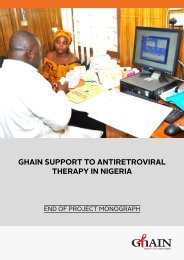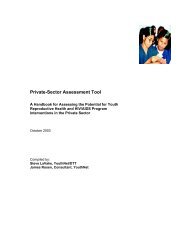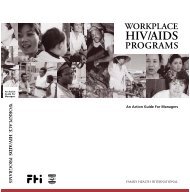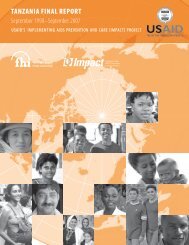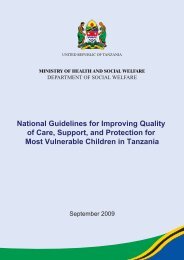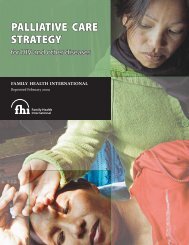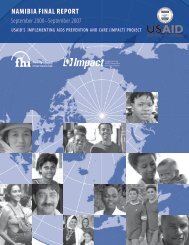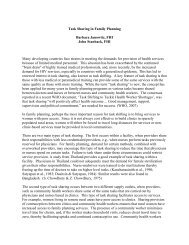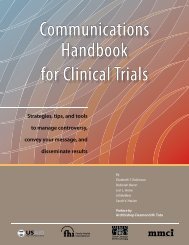2nd National Conference on Orphans and Other ... - FHI 360
2nd National Conference on Orphans and Other ... - FHI 360
2nd National Conference on Orphans and Other ... - FHI 360
You also want an ePaper? Increase the reach of your titles
YUMPU automatically turns print PDFs into web optimized ePapers that Google loves.
SLIDE 1: TITLE – “OVC ONE YEAR ON”<br />
You will remember that you gave us a m<strong>and</strong>ate<br />
last year <strong>and</strong> instructed us to report back to you<br />
within a year. This presentati<strong>on</strong> is an overview<br />
of the work, work plans <strong>and</strong> achievements of<br />
the OVCNSC during the last year. A copy of the<br />
OVC five-year strategy with subgroup work plans<br />
is c<strong>on</strong>tained in the c<strong>on</strong>ference h<strong>and</strong>out pack.<br />
SLIDE 2: CONFERENCE OUTCOMES<br />
“STRATEGIES”<br />
As you will recall, we came up with a number of<br />
key strategies at our c<strong>on</strong>ference last year:<br />
Develop a nati<strong>on</strong>al home-based family <strong>and</strong><br />
orphan support programme.<br />
Develop a plan of acti<strong>on</strong> to mobilise all stakeholders’<br />
input for a co-ordinated resp<strong>on</strong>se<br />
to OVC.<br />
Develop a nati<strong>on</strong>al policy <strong>on</strong> OVC.<br />
Strengthen the existing preventi<strong>on</strong> <strong>and</strong> care<br />
activities through a multi-sectoral <strong>and</strong> coordinated<br />
process whereby they become<br />
community owned <strong>and</strong> of direct benefit to<br />
OVC.<br />
Develop <strong>and</strong> strengthen existing networking<br />
forums for OVC at all levels including the<br />
c<strong>on</strong>stituency <strong>and</strong> regi<strong>on</strong>al levels.<br />
SLIDES 3-4: WHAT HAVE WE LEARNT?<br />
The UNICEF-supported study undertaken by<br />
SIAPAC, titled “A Situati<strong>on</strong> Analysis of Orphan<br />
Children in Namibia”, was finalised shortly after<br />
the c<strong>on</strong>ference last year, <strong>and</strong> the informati<strong>on</strong> it<br />
c<strong>on</strong>tains has impacted <strong>on</strong> the OVCNSC’s work.<br />
The Minister of Health <strong>and</strong> Social Services will<br />
Report-back from<br />
OVC <str<strong>on</strong>g>Nati<strong>on</strong>al</str<strong>on</strong>g> Steering<br />
Committee (OVCNSC)<br />
Ms Petr<strong>on</strong>ella Masabane<br />
Deputy Director of Social Welfare Services,<br />
DDSWS, MoHSS, <strong>and</strong> OVCNSC Chairpers<strong>on</strong><br />
launch the study this afterno<strong>on</strong> <strong>on</strong> behalf of the<br />
First Lady, but I would like to share with you<br />
now some of the key findings:<br />
By 2021 Namibia’s populati<strong>on</strong> will be 33%<br />
lower due to AIDS.<br />
As of 2001 there are an estimated 82 671<br />
orphans in Namibia. By 2021 there will be<br />
an estimated 251 054 orphans, 200 000 (¾)<br />
of whom will be AIDS orphans.<br />
As of 2001 it is estimated that half of all<br />
orphans in Namibia are AIDS orphans. This<br />
number will rise to some 75% by 2005 <strong>and</strong><br />
remain at over 75% until 2021.<br />
In terms of AIDS orphans the ‘worst-affected’<br />
areas of Namibia are currently the four northcentral<br />
Ohangwena, Oshikoto, Oshana <strong>and</strong><br />
Omusati Regi<strong>on</strong>s, the north-eastern Caprivi<br />
<strong>and</strong> Kavango Regi<strong>on</strong>s, <strong>and</strong> Windhoek in the<br />
Khomas Regi<strong>on</strong> in central Namibia.<br />
The four north-central regi<strong>on</strong>s ‘generate’<br />
some 50% of all orphans <strong>and</strong> care for over<br />
60% of all orphans. The Caprivi, Kavango<br />
<strong>and</strong> Windhoek are the next worst affected.<br />
As of 2001 orphans (AIDS <strong>and</strong> n<strong>on</strong>-AIDS)<br />
comprise an estimated 20% of all children<br />
in Namibia aged 17 <strong>and</strong> younger, <strong>and</strong> this<br />
will rise to 40% by 2021.<br />
SLIDE 5: WHERE ARE WE NOW?<br />
At its first meeting the OVCNSC planned to meet<br />
every quarter, which brought us in line with this<br />
year’s c<strong>on</strong>ference. All the elected members have<br />
been committed, <strong>and</strong> all attended every meeting.<br />
We also co-opted a number of members – key<br />
role-players whose support is needed:<br />
Church Benevolence Board of the Dutch<br />
Reformed Church<br />
2 <str<strong>on</strong>g>2nd</str<strong>on</strong>g> <str<strong>on</strong>g>Nati<strong>on</strong>al</str<strong>on</strong>g> <str<strong>on</strong>g>C<strong>on</strong>ference</str<strong>on</strong>g> <strong>on</strong> <strong>Orphans</strong> <strong>and</strong> <strong>Other</strong> Vulnerable Children – Windhoek, Namibia, 25-27 June 2002: Full Report


